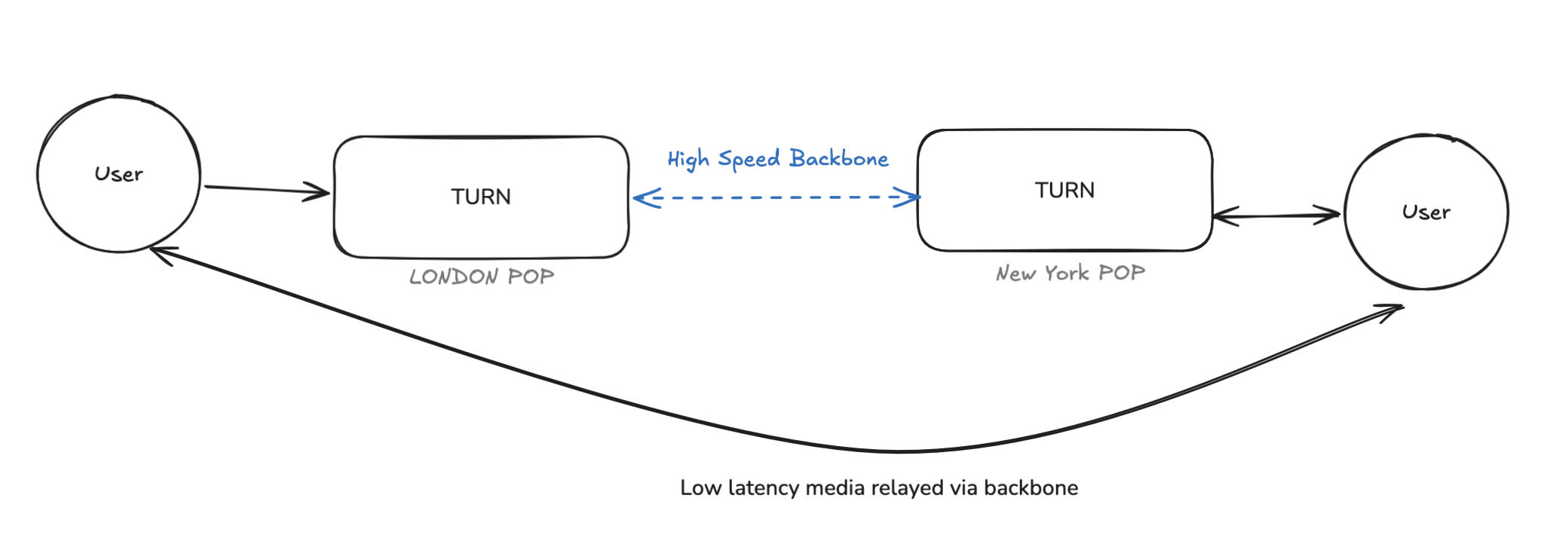What is TURN? Why TURN?
TURN (Traversal Using Relays around NAT) is the reliability safety‑net for real‑time communication. When peer‑to‑peer media cannot flow directly because of firewalls or restrictive NATs, a TURN server steps in as a secure relay so your calls, streams or IoT data always get through.
NAT Traversal in a Nutshell
Most home and corporate networks sit behind Network Address Translation (NAT) gateways and deep‑packet‑inspection firewalls. These devices rewrite IP addresses and block unsolicited traffic—great for security, painful for peer‑to‑peer (P2P) media.
WebRTC solves this with ICE (Interactive Connectivity Establishment), which tries different techniques in order of cost/performance:
| Layer | Technique | Purpose |
|---|---|---|
| 1 | Host candidates | Direct local/LAN connection |
| 2 | STUN (Session Traversal Utilities for NAT) | Discover public IP/port; works when NAT is “friendly” |
| 3 | TURN (Traversal Using Relays around NAT) | Full relay fallback; guarantees connectivity even through symmetric NAT, carrier‑grade NAT, or strict firewalls |
If STUN fails, TURN ensures the session can still be established by relaying packets through a publicly reachable server.
What is STUN?
STUN is a lightweight protocol (RFC 5389) that tells a client “what do I look like on the public internet?” Clients send a small UDP packet to a STUN server; the response reveals the mapped public address so peers can try to talk directly.
Limitations of STUN
- Symmetric NAT / Carrier‑Grade NAT rewrite each destination uniquely—STUN‑discovered ports become useless.
- Enterprise firewalls may block or rate‑limit UDP altogether.
- Certain Wi‑Fi hotspots block inbound traffic entirely.
When any of these apply, TURN is required as directly connection with the peer cannot be established.
What is TURN?
TURN (RFC 5766) allocates a temporary relay on a public IP. Both peers send their encrypted media streams to the TURN server, which forwards them to the other side.
It is essentially a smart proxy that supports UDP, TCP, TLS, and DTLS, allowing it to tunnel through almost any network condition.
Metered TURN Server operates on ports 80 and 443 to masquerade as normal HTTPS traffic, preventing it from being blocked by enterprise firewalls.
How TURN Works (Step‑by‑Step)
- Client requests a relay allocation from the TURN server.
- Server returns a public relay IP/port and credentials.
- Peers exchange these details via the signaling layer.
- Each peer sends SRTP/DTLS packets to the relay; TURN forwards to the opposite peer.
The server cannot decrypt the data that flows through it and the payload remains end‑to‑end encrypted.
Core Benefits of TURN
- Guaranteed Connectivity – Works through the worst NATs and firewalls.
- Low Latency & High Throughput – Optimised relays alllow low latency and high throughput
- Security – WebRTC mandates SRTP/DTLS; TURN simply forwards ciphertext. Use
turns:for full TLS wrap. - Protocol Flexibility – UDP, TCP, TLS & DTLS on 80/443 plus any high ports.
- DataChannels – Not just media; TURN relays arbitrary data (gaming, file‑transfer, control messages).
5. Typical Use‑Cases
| Use‑Case | Why TURN Matters |
|---|---|
| Voice & Video Calls | Reliable fallback path keeps calls from dropping in corporate/VPN environments. |
| Live & Interactive Streaming | Maintains sub‑second latency even when viewers are behind strict NAT. |
| IoT & Embedded Devices | Many devices sit on cellular or NAT‑ed networks with no port‑forwarding; TURN guarantees command & telemetry flow. |
| AI / 3D Rendering / AR‑VR | High, symmetric bandwidth over TURN’s fast relays enables real‑time model streaming and remote rendering. |
| Real‑time Surveillance | TURN over TLS punches through locked‑down enterprise networks while protecting video feeds. |
| DataChannels (chat, gaming, file‑share) | Ensures P2P data works everywhere. |
TURN & STUN with Metered Video
Specialized High-Speed Backbone
One unique advantage of our TURN infrastructure is a specialized high-speed backbone that links our global TURN servers. For example, if one user is in London and another in New York, each connects to their nearest TURN server. These TURN servers are then interconnected via our private, high-speed backbone—ensuring ultra-low-latency, high-throughput communication between continents.
This design dramatically reduces the time media spends in transit compared to standard internet routing, enabling:
Consistently lower latency for long-distance calls.
Stable performance even when public internet routes are congested.
High reliability for mission-critical real-time applications.
Whether you're running an international video conference, a collaborative AR/VR session, or a cross-continent multiplayer game, the specialised backbone ensures your users experience the smoothest, most responsive connection possible.

- Global network of 31 + regions & 100 + edge PoPs with < 30 ms round‑trip latency worldwide.
99.999 % uptime SLA for mission‑critical production workloads.
Automatic geo‑routing to the nearest PoP or pin traffic to a chosen region for data‑residency compliance.
Runs on ports 80 & 443 (UDP/TCP/TLS/DTLS) to bypass enterprise firewalls and deep‑packet inspection.
Up to 10× higher TCP throughput and 220 % faster UDP vs other providers—ideal for bandwidth‑hungry AI, 3D and live‑stream apps.
Powerful REST API to create/disable credentials, set auto‑expiry, and fetch per‑user usage metrics.
24 × 7 support by WebRTC engineers – Get help from people who debug ICE for a living.
Why Choose Metered TURN
- Enterprise ready from day one
- Built and operated by WebRTC specialists since 2013.
- Transparent Pricing
- Best‑in‑class performance validated by third‑party benchmarks.